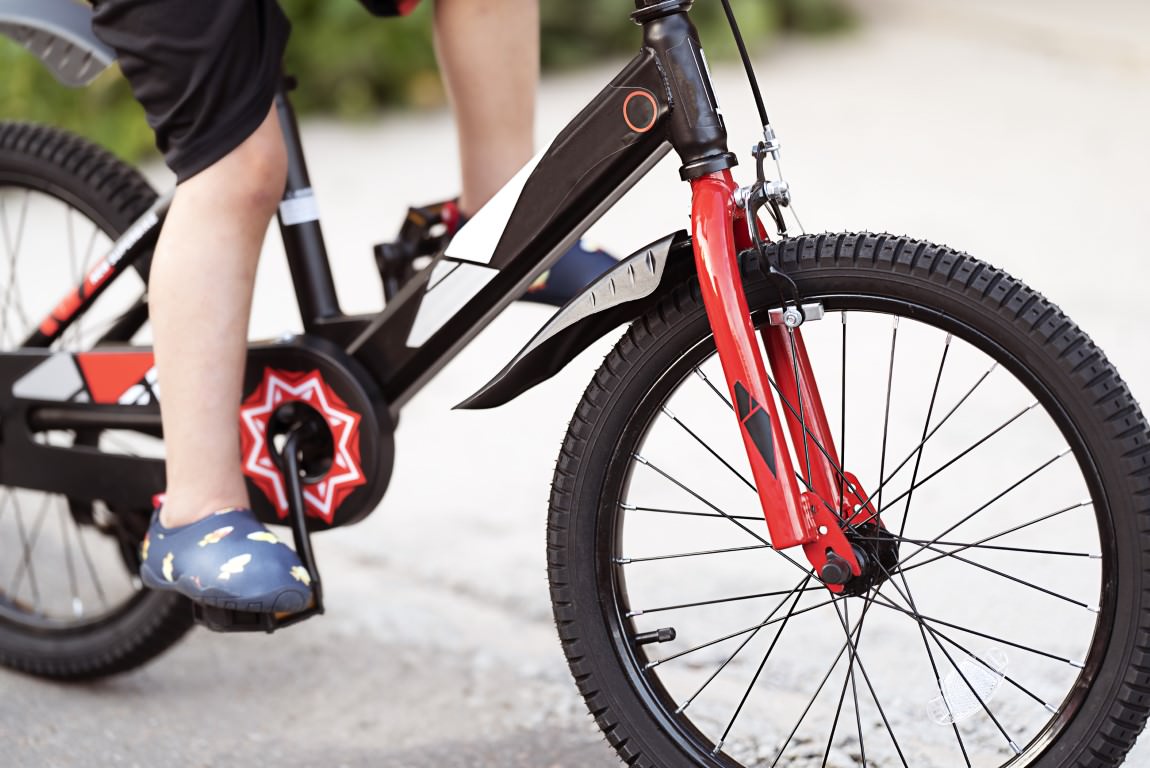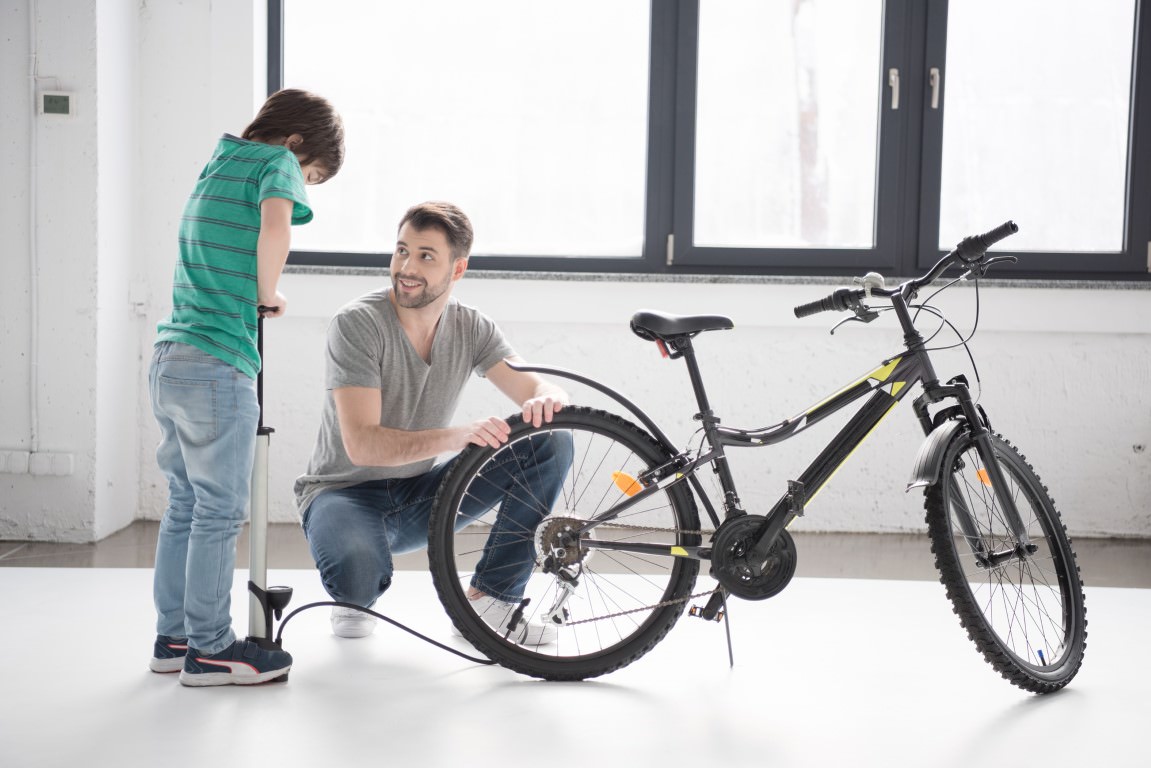Tire Pressure: Kids’ bikes vs adults’ bikes
When it comes to tire pressure, it’s important to acknowledge the differences between kids’ bikes and adults’ bikes. Kids’ bikes generally use smaller tires and support lighter weights, whereas adults’ bikes must accommodate a larger range of weights and tire sizes. This directly impacts the recommended tire pressure, expressed in PSI (pounds per square inch), for each type of bike.
For kids’ bikes, the recommended tire pressure usually falls within the 20-40 PSI range. This lower pressure provides a more comfortable ride, optimal traction, and helps reduce the risk of flat tires caused by overinflation. On the other hand, adult bike tires typically range from 40-100 PSI, depending on factors such as the type of tire and the rider’s weight.
It’s crucial to maintain the appropriate tire pressure for a number of reasons:
- Comfort: Properly inflated tires provide a smoother and more comfortable ride, regardless of the bike or rider’s age.
- Traction: Optimal tire pressure improves grip on various road surfaces, ensuring better control and safety.
- Wear: Incorrect tire pressure can lead to uneven wear and a shorter lifespan for bike tires.
- Efficiency: Adequate tire pressure makes pedaling and maintaining momentum easier, reducing rider fatigue.
To determine the ideal tire pressure for a specific bike, it’s important to refer to the manufacturer’s recommended PSI range, usually found on the tire’s sidewall or in the owner’s manual. It’s also essential to consider the rider’s weight and the type of road surface they will be riding on, as these can impact the optimal tire pressure.
Remember to regularly check and adjust your tire pressure for a safer and more enjoyable ride. Inflating tires with a suitable bike pump equipped with a pressure gauge ensures accuracy and avoids the risks associated with over- or under-inflated tires.
How to Find the Recommended Tire Pressure for Your Child’s Bike
Finding the recommended tire pressure for your child’s bike ensures a safer and more comfortable ride. It’s important to consider factors such as speed, wheel size, and terrain when determining the optimal tire pressure.
The recommended pressure for a children’s bike is generally lower compared to an adult bike. This is because kids usually weigh less, thus requiring less air pressure to support their weight. To find the specific air pressure required for your child’s bike, look for the manufacturer’s recommendations on the tire’s sidewall. It’s usually shown as a range (e.g., 35-65 PSI).
Speed plays a role in tire pressure adjustments. If your child rides at high speeds, a slightly higher tire pressure could be beneficial for smoother rolling and reduced resistance. On the other hand, a lower tire pressure can provide better traction and stability for lower-speed rides.
Wheel size and diameter also affect the ideal tire pressure. Smaller wheels may require a slightly higher pressure, while larger wheels can handle lower pressures. Check the bike’s specifications or consult the manufacturer for the correct tire size and corresponding recommended tire pressure.
The terrain your child cycles on can influence the necessary air pressure. For example:
- Road cycling: Higher tire pressure for less rolling resistance and smoother rides.
- Off-road or gravel: Lower tire pressure for better traction and shock absorption.
- Mixed terrains: Adjust tire pressure accordingly for optimal performance and comfort.
Use a reliable bike pump with a built-in or separate pressure gauge to inflate the tires, so that you can accurately measure the air pressure. Remember to occasionally check the tire pressure, as it can change due to factors like temperature fluctuations and natural air loss over time.

Average Tire Pressure by Age/Wheel Size
Every bicycle tire has a recommended pressure range indicated on its sidewall. The suggested pressure for kids’ mountain bike tires is generally lower, while kids’ road racing bicycle tires have a higher recommended pressure. Most kids’ pedal bike tires, designed for neighborhood rides and light gravel or dirt paths, fall between these two categories. It’s common to use pressures on the lower end of these recommended ranges for kids due to their lighter weights.
The below tire pressures are rough ranges for an average-use bike, dependant on tire size:
2 to 4 Years Old (14-Inch Wheels)
At this age, kids typically ride on 14-inch wheels. It’s important to ensure the tire pressure is maintained within the appropriate range for a safe and comfortable ride. For 14-inch wheels, aim for a tire pressure between 25 and 35 PSI (pounds per square inch).
4 to 6 Years Old (16-Inch Wheels)
When kids are between 4 and 6 years old, their bikes tend to have 16-inch wheels. The recommended tire pressure for this wheel size is generally around 30 to 40 PSI. This range provides a good balance between comfort, stability, and ease of pedaling.
5 to 8 Years Old (20-Inch Wheels)
Children aged 5 to 8 years might ride bikes with 20-inch wheels. In this case, an appropriate tire pressure should be maintained between 35 and 45 PSI for optimal performance and safety.
8 to 11 Years Old (24-Inch Wheels)
As kids grow, their bikes need to accommodate their increased size and weight. Bikes with 24-inch wheels are often used by 8 to 11-year-olds. The ideal tire pressure for this wheel size ranges from 40 to 50 PSI, allowing for a comfortable and secure riding experience.
11 to 14 Years Old (26-Inch Wheels)
For ages 11 to 14, it’s common for kids to transition to bikes with 26-inch wheels. Maintaining a tire pressure of 45 to 55 PSI is recommended during this time. This range helps ensure a smoother ride while still providing necessary support and control.
Please note that these are just rough ranges; you should always check the tires to find the exact pressure you should be running them at.
How Often Should You Check Your Child’s Bike Pressure?
Maintaining the proper tire pressure for your child’s bike is essential for both safety and comfort. It’s important to check the air pressure regularly to ensure your child a smooth and enjoyable ride. Doing so will not only prolong the life of the tires, but it will also ensure a better riding experience. In this section, we’ll discuss how often you should check tire pressure and some tools you can use to make it easy.
As a general rule of thumb, checking your child’s bike tire pressure at least once a month is recommended. This frequency should increase during seasons with fluctuating temperatures, as changes in weather can cause the air pressure inside the tires to be affected. It’s also a good idea to perform a quick check before any longer rides or trips, to make sure your child’s bike remains safe and comfortable throughout the journey.
You’ll need a tire pressure gauge or a bike pump with an integrated gauge to check the tire pressure. Here’s how to do it:
- Locate the tire valve and remove the valve cap.
- Attach the pressure gauge or pump to the valve.
- Take note of the pressure reading on the gauge.
- Use the bike pump to adjust the pressure to the recommended level if necessary.
It’s essential to know the recommended tire pressure for your child’s bike, as it can vary depending on the type of bike and tire size. This information can usually be found on the sidewall of the tire or in the bike owner’s manual. Always maintain the suggested pressure levels for optimal safety and comfort.
Tire Pressure Adjustment for Different Riding Conditions
Understanding how to adjust your child’s bike tire pressure according to different riding conditions is essential for optimal performance and safety. Different road surfaces, weather conditions, and terrains can all affect the appropriate tire pressure.
- Wet or slippery surfaces: When riding on wet or slippery surfaces, slightly reducing tire pressure can improve traction and stability. Lower tire pressure allows the tire to deform and provide a larger contact area with the ground, which can result in better grip on slick surfaces.
- Off-road or bumpy terrain: Lower tire pressure can also be beneficial when riding on off-road or uneven terrains. A softer tire can better absorb impacts and provide increased traction on loose or rocky surfaces.
- Sandy or soft surfaces: In situations where the ground is soft or sandy, a slightly lower tire pressure may help prevent the tires from sinking into the surface, thus maintaining momentum and control.
- Cold weather: Air pressure inside tires can decrease in cold weather, so it’s crucial to check tire pressure more frequently during winter months. Consider adding a few extra PSI to compensate for the cold temperatures.
Remember that these adjustments should still stay within the recommended tire pressure range provided by the bike manufacturer. Experimenting with different tire pressures within this range can help you find the optimal pressure for specific riding conditions and maximize your child’s safety and enjoyment.
Other Considerations to Consider
In addition to tire pressure, several other factors can affect your child’s bike performance and safety. When maintaining your child’s bike, be sure to consider the following aspects:
- Tire wear and damage: Regularly inspect your child’s bike tires for signs of wear or damage, such as cuts, punctures, or bald spots. Damaged or worn-out tires can compromise the bike’s performance and safety. Replace tires as needed to ensure a safe and enjoyable riding experience.
- Proper tire type: Different types of tires are designed for specific riding conditions and terrains. Ensure that your child’s bike is equipped with the appropriate tire type for their riding habits, whether it’s road cycling, mountain biking, or a mix of both.
- Tire width: Wider tires can provide better traction, stability, and comfort on rough or off-road terrains, while narrower tires are more suitable for smooth road surfaces and higher speeds. Make sure your child’s bike has the correct tire width for their riding needs.
- Proper bike fit: A bike that is too big or too small for your child can be difficult to control and uncomfortable to ride. Regularly check and adjust the bike’s seat height, handlebar height, and reach as your child grows, to ensure a proper fit and safe riding experience.
- Bike maintenance: Regularly inspect your child’s bike for any loose or damaged components and make any necessary adjustments or repairs. A well-maintained bike is not only safer but also more enjoyable to ride.
Taking these factors into consideration will help you provide your child with a safe, comfortable, and enjoyable biking experience. Keeping tire pressure within the recommended range, along with regular bike maintenance and adjustments, will ensure optimal performance and safety for your child.
